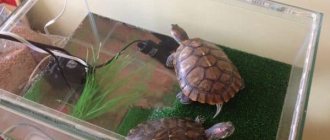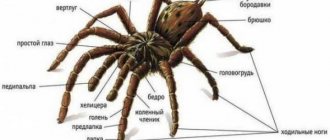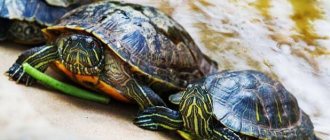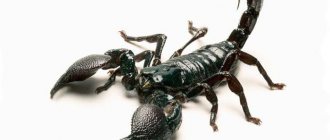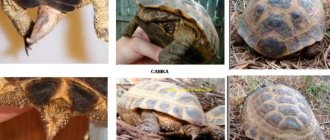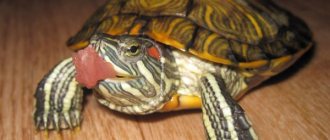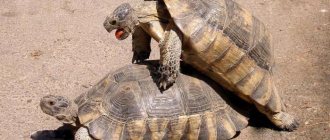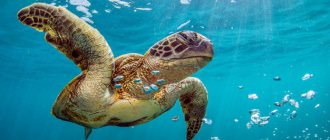The turtle in nature is a representative of the most ancient inhabitants of the planet; the uniqueness of the animal lies in the unusual design of the skeleton, in which the skeletal system is connected to a hard protective shell in the form of a shell. The turtle's shell protects it from the negative influences of the surrounding world and makes it one of the slowest animals on the planet.
In total there are more than 200 species of turtles. Most of them are light in weight and reach several tens of centimeters in length. The weight of large species reaches 700-900 kg, with the main weight concentrated on the shell. The smallest variety weighs 100-200 g. Turtles can live both in the wild and at home. You can learn a lot of useful information about pet turtles here.
Turtle: description, characteristics
- Different species are adapted to their habitat - some prefer water, others live on land. Aquatic reptiles are predators. Their diet includes fish, shellfish, and invertebrates. In nature, the land turtle feeds primarily on plant foods.
- Turtles are long-lived . The average life expectancy is 150-200 years. These animals have inhabited planet Earth for more than 200 million years. In addition to bone shelter from adverse factors, nature has endowed turtles with good eyesight and excellent hearing. When cold weather sets in, turtles go into hibernation.
Elephant
Nutritional Features
The squirrel can be considered an omnivorous rodent; it can use for food:
p, blockquote 4,0,0,0,0 –>
- seeds from coniferous trees (spruce, pine, cedar, fir);
- hazel, acorns, nuts;
- mushrooms;
- buds of young plants;
- berries;
- plant roots;
- lichen;
- herbs.
If the year is lean, then most of their diet consists of grasses and roots. During the mating season, squirrels prefer to eat animal food: insects, larvae, eggs of small birds, small vertebrates. In early spring, they can gnaw on the bones of dead animals.
p, blockquote 5,0,0,0,0 –>
For the winter, they prefer to make supplies, which are stored in hollows, rhizomes, or simply hung on trees with dense branches. Such products include: nuts, mushrooms, pine cones, acorns. They do not remember about their reserves and often find them by accident. Squirrels can feed on the supplies of other animals.
p, blockquote 6,0,0,0,0 –>
The benefits of turtles in nature
- In nature, the turtle is a natural link in the food chain. In ancient times and in the modern food industry, turtle meat is used for cooking.
- Turtle shell is used for decorative purposes and in jewelry production. The symbolism of turtles is used in mythology, art, and heraldry.
- Turtles are representatives of the oldest species of animals and record holders for longevity. Unique animals deserve human care.
Turtle body structure
- Turtles have very well developed limb muscles. The mammal travels long distances on its 4 legs, carrying a huge heavy shell.
- The animal's head has a streamlined shape for comfortable camouflage inside the shell. In most varieties, the eyes are located on the sides of the head and directed towards the bottom. Food absorption occurs with the help of a hard front beak.
- In land turtles, the forelimbs are adapted for digging, and the hind legs allow them to push a heavy shell forward. In freshwater species, dense membranes are formed on the paws, connecting the toes into fins. Movement in water occurs mainly with the front paws, so their size is significantly larger than the hind paws.
- All types of turtles have a small , pointed tail. Several exotic species have a conical spine at the tip. The cervical and caudal sections of the spine are movable, the rest of the skeleton is connected to the shell.
Structure
Sense organs and higher nervous activity.
Turtles are good at distinguishing odors at close range and, judging by some observations, use their sense of smell when choosing food. Vision is also well developed: these animals can be taught to recognize contours and colors. Both the shell and scaly skin have tactile sensitivity, and the giant tortoise even feels the pressure of a straw that is passed along its massive carapace. Although it has long been known that turtles are sensitive to vibrations transmitted through the soil, their ability to perceive airborne sound waves has long been controversial. Today the existence of at least weak “ordinary” hearing in them is considered proven.
Compared to other reptiles, turtles are very smart. They easily learn to follow their owner, seem to enjoy the attention they receive, and get used to a certain routine well. Apparently, some individuals are smarter than others. For example, among six Agassi gophers (Gopherus agassizi) living together, one individual, of its own volition, climbed up an inclined plane onto a platform and slid down the other side down a metal chute. She obviously enjoyed this activity and repeated it for hours on end. But in some situations, turtles are surprisingly slow-witted. For example, they may spend a lot of energy climbing over an obstacle that is not difficult to get around; or for a long time they try to squeeze through a gap that is much smaller in size.
What does a turtle without a shell look like and what is it made of?
- Another unique feature of the turtle is the presence of an internal and external skeleton. The turtle's shell is tightly fused with the ribs and vertebrae; without it, the animal's life is not possible. The presence of a bone structure limits the development of the trunk muscles.
- The thoracic region is lined with oblong vertebrae that pass into the sternum. 33 vertebrae in the turtle's tail , which provide it with mobility. The hip bones are very short and are an integral part of the frame and spine.
- The freshwater turtle is found in nature with a frame made of soft tissues covered with rough skin. Relatively light weight facilitates rapid movement and performs protective functions when encountering danger.
Without a shell
turtle shell
- The main feature in the structure of turtles is the shell. The abdominal frame has a flat shape. The bone formation located along the spine has the shape of a semicircle. The upper and lower parts of the shell are connected to each other by bone membranes.
- The surface of the shell is covered with horny scales. Its strength can withstand a load exceeding 200 times the weight of a turtle. The scales of the shell and the rough skin of the body are renewed during the molting process.
- The shell is a reliable shelter . At the slightest threat, the mammal easily transforms the soft parts of the body and hides them under a bone capsule. The neck muscles allow you to completely pull your head inward, leaving only pinholes for breathing outside.
- Any mechanical damage to the shell in the form of abrasions or cracks can provoke a fungal disease. Therefore, despite their external invulnerability, turtles must be handled very carefully.
- Along with its protective functions, a tortoise shell helps to retain heat. Blood vessels pass through it. Due to the many nerve endings, the turtle is able to feel pain and discomfort when mechanically applied to the bone plate.
Shell and skeleton
Does a turtle have teeth and how many?
- The turtle has no teeth. Chewing food is carried out using horny plates covering the inside of the mouth and pharynx. The textured coating easily handles hard products and grinds plant tubers and stems.
- Excessive salivation contributes to the formation of food lumps, which can remain in the mouth and esophagus for a long time. Promotion of food is carried out using a massive tongue. The limited functionality of the tongue does not allow it to stick out of the mouth.
- In some species of turtles, the tongue is covered with taste buds. Varieties that do not feel taste are less picky about food. Digestion of one turtle meal can take about a week. The functioning of the digestive tract depends on temperature conditions.
Without teeth
Harmful products
Some plants are harmful to reptiles:
- medicinal plants containing alkaloids;
- poisonous plants of the nightshade and buttercup families;
- dieffenbachia;
- elodea;
- spurge;
- azalea;
- hydrangea;
- daffodils;
- ambulia;
- saffron;
- cyclamen;
- digitalis;
- delphinium;
- lily;
- jasmine;
- lupine.
The following products are contraindicated:
- boiled, fried, boiled food;
- sausages, minced meat, pates;
- citrus;
- tops, root crops of radishes, potatoes and radishes;
- avocado;
- eggplant;
- gooseberry;
- parsley;
- cabbage;
- rhubarb;
- berry, fruit seeds;
- porridge;
- dairy products;
- bread;
- food for warm-blooded animals;
- crab sticks;
- tomatoes.
Remember that you should not completely abandon heat treatment of meat. Pour boiling water over meat products to minimize the risk of infecting the turtle with parasites. Feed mixtures containing a lot of fishmeal, dyes and preservatives can also cause harm.
Products available in limited quantities:
- apples;
- corn;
- radish;
- asparagus;
- squid;
- legumes;
- cereal grains, mustard;
- fatty fish and meat;
- pineapples;
- raspberries, strawberries;
- watermelon and melon;
- locusts, crickets, cockroaches;
- onion garlic;
- basil;
- too sweet fruits and berries.
How does a turtle breathe?
- The turtle breathes through its nasal passages. The openings of the nose are easily visible on the front of the head. Some varieties have a small elongated proboscis.
- Turtles do not have a rib cage , so the voluminous lungs fill the entire upper part of the space under the semicircular shell. The heavier the bone armor, the larger the lung capacity. When inhaling, muscle ligaments and pulmonary muscles contract in the turtle’s body.
- The turtle's breathing is measured. Its frequency depends on the living conditions of the mammal. Freshwater and sea turtles can survive without air for several hours, after which they need to come to the surface of the water and get a new portion of oxygen. Land mammals take about 5 breaths per minute.
- Several species of sea turtles use alternative methods of breathing - through the surface of the skin or special sinuses in the respiratory system. The structural features of the mammalian respiratory system exclude reflex coughing or sneezing. Retention of mucus in the respiratory tract often leads to the development of pneumonia.
How to determine the sex of a turtle?
Sexual differences in turtles can only be noticed upon careful examination. External differences between male and female mammals include:
- Shell shape. In females, the shell is elongated into an oblong shape; in males, the shape is more like a flattened oval.
- Plastron shape. On the lower part of the shell, on the side of the tail, males have a depression that facilitates the process of reproduction. In females in this area the plastron is flat.
- Tail length. The tail of female mammals is elongated and straight. Males have a longer tail and more massive at the base.
- Location of the cloaca. In females, the anus is located at the base of the tail and has a rounded shape. In males, the cloaca, in the shape of an elongated seed, is located in the lower third of the tail.
- Nail length. Males have much longer nails on their front paws than females. This feature is a convenient tool for mating.
Determination of gender
Where do turtles live in nature?
- Marine species of turtles live in seas and oceans. Heat-loving animals prefer tropical and temperate climates. The animal cannot survive on cold continents, so it chooses areas with warm open currents and coastal waters. To access air, sea turtles stay close to the surface of the water and often become a catch for people.
- Land turtles prefer areas with arid climates. Animals inhabit desert and steppe lands in southern Europe, Australia, America, and Africa . Several species live in tropical rainforests. In mountainous areas you can meet a turtle at an altitude of 1-1.5 km. There are about 60 species of land reptiles.
- Freshwater turtles live in Europe and Asia near various freshwater bodies. Small rivers, lakes, and seasonal reservoirs are preferable. Freshwater turtles in Russia are found naturally in the regions of the North Caucasus.
- The unusual red-eared turtle is found naturally in North and South America. In Italy they are considered plant pests. You can learn more about the red-eared slider here.
- The snapping turtle , which can bite humans, is found in Canada and the United States. The large green turtle lives in the seas of the Pacific and Atlantic oceans.
Chelydridae
(snapping turtles). The family includes only 2 species, of which the best known is the snapping turtle (Chelydra serpentina). It is an aquatic reptile native to much of North America and northwestern South America, abundant in southeastern Canada and the eastern half of the United States, where it is highly prized as a food item. Snapping turtles are unfairly blamed for killing large numbers of fish and waterfowl. The weight of these animals often reaches 13.6 kg. When pulled out of the water, they can bite painfully.
Another species, the snapping turtle (Macrochelys temmincki) is one of the giants of the order, reaching a mass of approx. 90 kg. Not only are they the heaviest of its freshwater species, but they are also the most water-bound of the North American turtles. They are found in the southeastern United States, mainly in the lower Mississippi. Being slow, the snapping turtle lures prey with the help of a fleshy outgrowth of the bottom of the mouth, which moves in its open mouth like a worm.
What do turtles eat in the wild?
- Turtles are omnivores. The diet of sea and freshwater turtles consists of fry of fish, crustaceans, mollusks, and tadpoles. Large individuals hunt large fish and frogs. A hungry turtle is capable of eating a defenseless relative.
- Land turtles eat mainly plant foods. Animals eat plant stems, vegetables, fruits, and mushrooms. Under favorable conditions, it is not averse to feasting on small insects and small living creatures from reservoirs.
Nutrition
- Rotten food is easier to chew, so turtles do not refuse rotten fish and spoiled fruits.
- At home, pets replace their usual food with algae, salad leaves, vegetables, aquarium fish and snails.
Herbivores
These are the majority of land turtles:
- Central Asian;
- Mediterranean;
- Indian;
- Balkan;
- panther;
- Egyptian, etc.
95% of their menu is made up of food of plant origin: various weeds (clover, dandelions), vegetables and fruits. Therefore, they are herbivores that only occasionally consume animal food. In captivity, land turtles are given some boiled chicken eggs (whites only) for variety.
The land turtle is a herbivorous representative of the animal world, since it cannot run quickly after prey and does not have sharp teeth. In addition, her digestive system cannot cope with the digestion of heavy animal food, and plants are the main source of nutrients, vitamins and moisture.
How do turtles reproduce and are born?
- During the breeding season, the turtle's behavior can be used to determine its sex. Interested males surround females with obsessive attention, discouraging her from rivals. The behavior of males is marked by rhythmic shaking of the head and touching the female’s face with the forelimbs.
- The female behaves more indifferently. When the female ignores the male, he begins to bite aggressively.
- Depending on the living conditions, puberty of turtles occurs at different ages. Freshwater turtles are ready to bear offspring at 6-8 years of age , while land turtles lay eggs at 10-15 years of age.
- Mating can occur both on land and in water. The duration of sexual intercourse is a quarter of an hour. The male is pressed against the female due to the concavity of the lower part of the shell. Fixes the position by clinging with tenacious claws or hugging with flat flippers.
Birth
Dermochelyidae
(leatherback turtles). The leatherback turtle (Dermochelys coriacea) is the only living species of this family. This giant can reach a mass of more than 680 kg with a front flipper span of 3.6 m. The leathery shell bears 7 longitudinal ridges on the dorsal side and 5 on the ventral side. Although the range of these turtles covers all warm oceans, they are the rarest among the widespread marine species of the order. The question of the systematic position of the group remains controversial. It was allocated to a special suborder Athecae (scutellae), but most experts agree only on the rank of superfamily.
How many eggs does a turtle lay?
- Turtles are prone to fertilization only in comfortable conditions - with favorable ambient temperatures and a full stomach. The active breeding season occurs in spring.
- To protect their offspring, females lay eggs in familiar territory. Warm summer sand near water sources is the most comfortable place for future turtles.
- The gestation period for a turtle's offspring is 1-3 months. Mammals are capable of hatching up to 200 eggs 3-4 times throughout the year. Only a few manage to survive in the wild. Birds, fish, predatory animals, and even people are not averse to eating eggs.
Up to 200 eggs
Why do sea turtles lay eggs at night?
- To lay eggs, a sea turtle needs to get onto land. You can only see a turtle laying eggs in nature at night. To avoid large crowds of people, females prefer the dark. Land turtles are not associated with night time.
- To accurately distribute the clutch of eggs, the turtle digs a deep hole with its hind legs. Eggs are laid in sequence. For convenience, the turtle plunges its hind legs into the depression and evenly places the future offspring.
- The mammal buries the finished masonry with sand, levels the surface with the lower part of the shell and moistens it with its own secretions. This is where the mother turtle's participation ends. The fate of future offspring depends entirely on environmental conditions.
Freshwater
Its size also depends on where the turtle lives. Thus, animals living in fresh water bodies are usually smaller than their sea and land counterparts. As a rule, they do not exceed 40 cm in length, but soft-bodied turtles can be more than a meter. They live in river estuaries, lakes and swamps, preferring bodies of water with weak currents. Turtles can stay under water for a long time, hibernate and sleep without surfacing. They breathe through the skin of the palate or anal sacs, which open into the anus. Some species periodically come to land, while others are completely aquatic animals.
How do turtles winter?
- With the onset of cold weather, turtles hibernate. The animal digs an earthen den and falls asleep in it until the climate changes. The hibernation period lasts from the beginning of winter until warm spring.
- For hibernation, the correct temperature and health of the animal are important. Unfavorable factors can lead to illness in the turtle during sleep.
- Thanks to healthy winter hibernation, the animal’s life expectancy increases, hormonal processes are regulated, and excess fat deposits are processed.
Hibernation
Feeding rules
It is advisable to eat at the same time every day, preferably in the morning.
When feeding turtles, you must follow simple rules:
- Up to a year of age they are fed every day, after two years they can be fed every other day.
- Food utensils should always be washed clean before each feeding.
- Portions should be made small, and excess should be removed from the terrarium so that it does not spoil.
- Try to ensure complete rest for your pet while feeding. The turtle is frightened by loud sounds and sudden movements.
- Reptiles should not be taught to eat from their hands. They very quickly get used to this method of feeding, and then refuse to eat from the bowl.
- You should not overfeed your pets, that is, give food too often, this can lead to obesity and distortion of the carapace and plastron.
- Feeding too infrequently is also unacceptable, as this can cause exhaustion and death.
Why do turtles live long?
- How long turtles live in nature directly depends on environmental conditions. The main secret of turtles' longevity is that they are cold-blooded animals.
- They do not have to expend energy heating their own body , and, therefore, metabolism occurs at a very measured pace. It has been scientifically proven that a fast metabolism shortens life expectancy.
Turtles eat quite little; a long period without food does not affect the functioning of the body in any way. The infrequent process of digesting low-calorie food reduces the metabolic load on the body; such conditions are favorable for the long life of turtles.
- At home, the life expectancy of turtles is reduced.
- With proper care, a pet can live about 50 years.



